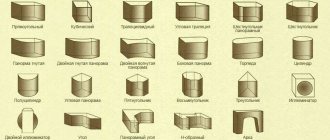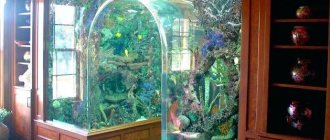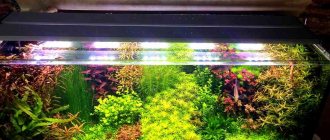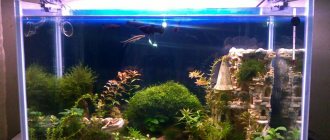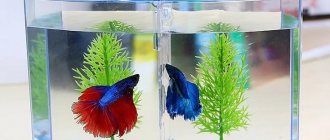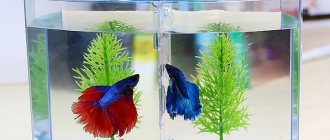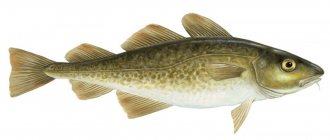Choosing a place for an aquarium
The first thing you should decide is where to place the aquarium. The location should not be chosen randomly. After all, even if you select good equipment and take care of the fish with love and care, if there is little or too much light, if the temperature is too low or high, the inhabitants of the aquarium will be uncomfortable. Its inhabitants may get sick and die.
What should you consider when choosing a place to install a “home pond”?
- Lighting. It is worth considering that an aquarium requires proper lighting, but installing it near a window would be the wrong decision. Bright direct sunlight can cause the water to “bloom,” which will add a lot of care and hassle to your care. The best choice would be to place the aquarium at the back of the room. Alternatively, you can place it along the wall, opposite the window or perpendicular to the window, so that the light falls only on the side and front walls. This way, the inhabitants of the aquarium will look much more advantageous, and the water will not bloom.
- Temperature conditions. The “home pond” should not be located close to heating radiators; this can cause overheating of the water in the autumn-winter period and further discomfort for its residents. Sudden changes in temperature are unacceptable, as is an increase in temperature to a critical norm.
- Electricity. When choosing a place to install an aquarium, consider the presence of a nearby electrical network to which you can connect many devices - lighting lamps, a filter, a compressor, a heater. Think in advance about how and where you will connect the equipment, and how to protect the sockets from accidental moisture. Be sure to note that there must be grounding, which will protect the equipment and your life and health.
What should I install the aquarium on?
A home “pond” must be located on a solid foundation, which can be used as furniture. It should be taken into account that during care the furniture surface may come into contact with water and be subject to deformation. Therefore, it is better to opt for a special aquarium stand or surface that is sufficiently durable and moisture resistant.
When choosing a solid base, you need to take into account the weight of one liter of fresh water, which is about 1 kilogram, plus the filling of the aquarium in the form of soil and equipment. For example, a 100-liter aquarium, fully equipped, will weigh about 120-140 kg. The aquarium cabinet must be strong and level to avoid distortions, which will create an uneven load on the walls of the aquarium, which can subsequently lead to cracks in the glass and leaks.
If you are a light sleeper, you should not install an aquarium in the bedroom, because... the equipment may be noisy. If you still want to have a “living decoration” in this room, purchase filters and compressors with low noise levels.
Do not place the aquarium near a TV or stereo system, because... Excessive vibration and electromagnetic fields can negatively affect the well-being of your pets. Make sure that there are no drafts in the room you choose to install the aquarium. A balcony where you or your household members smoke would not be the best option.
Choosing the right place to install an aquarium is the key to a long and healthy life for all its inhabitants!
Which aquarium to choose?
Types of aquariums
There are many types of aquariums that differ in different parameters.
To size
When choosing, you must first of all take into account the purpose of the aquarium and the chosen location for installation. There are general principles for choosing an aquarium by size. The best option is from 50 liters. You should not be tempted to buy too small aquariums (the so-called mini), in which the fish will be uncomfortable.
By shape
- Rectangular. They are distinguished by their versatility and ease of maintenance.
- Angular (triangular). Installed in the inner corner.
- Panoramic. Can be designed in the form of a rectangular or corner container. Their feature is beveled front corners.
- In the form of a hemisphere. They can be rectangular or angular with an arched front glass. Because of the curved glass, it is inconvenient to observe the inhabitants of the aquarium; there may be distortions.
- Overview. Presented in the form of a cylinder, polyhedron and other shapes that provide a comprehensive overview.
- Cubic (square).
- Spherical (round or pedunculated).
Aquariums by water composition
Depending on the type of inhabitants that you plan to populate in your “home pond,” aquariums are divided into marine and freshwater. Unlike a freshwater aquarium, equipping a saltwater aquarium requires more complex and expensive equipment.
You can read about what kind of water to pour into the aquarium in this article.
Freshwater aquariums
Pseudo-sea. Such an aquarium most often does not contain plants. When decorating it, different stones are used that resemble corals. One of the conditions for creating a pseudo-sea is high water hardness - up to 20°. For lighting, lamps that have a cool bluish tint are used.
Cichlids from African lakes, which feel good in hard water, are used as inhabitants. With their multi-colored colors, they resemble the inhabitants of coral reefs.
Aquarium pseudosea
Dutch. The inhabitants of such an aquarium are plants that are planted quite densely, so that if you look at the aquarium from above, the soil is almost invisible. The lighting source is lamps with a specially selected phosphor, which has increased light output and special spectral characteristics. In order to maintain the necessary biobalance, systems for enriching water with carbon dioxide are mandatory, as well as the use of complex fertilizers.
dutch aquarium
Salt water aquariums
Marine saltwater aquarium. Maintaining a saltwater aquarium is much more difficult than maintaining a freshwater one. If you can safely drain 1/3 of the water from a freshwater aquarium and add clean fresh water, then such manipulations in marine aquariums are almost unacceptable due to the high consumption of sea salt. The problem of replacing water in marine aquariums must be solved using sophisticated equipment for natural regeneration and cleaning devices - foam separating columns (these include flotators, skimmers). Another difference between a marine aquarium is the presence of currents, which are quite strong. Therefore, you will need powerful pumps that simulate a sea current.
Marine aquariums are:
- reef;
To create a reef aquarium, more sophisticated equipment and powerful lighting with a color temperature of 10,000K are used. The equipment used is metal halide lamps, which create the necessary conditions for keeping marine invertebrates. It is very desirable to have so-called “living stones”, which serve as a biological filter due to the organisms inhabiting them, including bacteria.
- fish.
These aquariums are very similar to freshwater ones. It is very important to choose the inhabitants wisely. Some fish behave aggressively even towards representatives of their own kind (a striking example of a fish is angels). Clownfish and sea anemones can exist peacefully with each other.
Seawater aquarium
Equipment
Modern companies offer both empty containers and fully equipped ones, the so-called Plug-and-go.
An empty aquarium is cheap. When purchasing it, you can choose the required form. But in addition to the can itself, you need to study information about filters, lighting and heaters. You will also have to install electrical wiring and protect it from splashing water.
Ready-made aquariums are fully equipped. When buying it, you won’t have to think about which filter to choose or how to install the lighting. The manufacturers have thought of everything. But such an aquarium will cost more, and they are recommended only for beginners to buy. The fact is that the equipment installed in it is not suitable for all hydrobionts. Fish such as discus require special conditions. And if you plan to grow a herbalist with demanding plants, then you will most likely have to buy one or two more lamps in addition to the standard lamps.
Separation of aquariums according to purpose
Aquariums are divided into such types as: decorative and special.
Decorative aquariums
They are used for aesthetic purposes to decorate the interior and monitor the life of the inhabitants and plants of the aquarium. This is the most common option, which serves mainly for keeping aquatic organisms: a common aquarium is populated with aquatic organisms from different systematic groups; collection - inhabited by close taxonomic groups, for example, fish of the same family; species-specific - inhabited by fish of only one species.
Special aquariums
Designed to solve specific problems, for example, for conducting experiments, raising fry, incubating eggs, breeding and treating fish and other purposes.
- Spawning. In this aquarium, favorable conditions are created that stimulate the breeding of fish, the size of which, as a rule, is smaller than decorative ones;
- Vyrostny. Used for raising young animals transferred from a spawning aquarium;
- Species. Used for keeping fish of the same species, for example, discus;
- Selective. It is used to breed new species of fish or to correct the decorative qualities of an existing breed (fin shape, color). Most often, aquarists use several breeding aquariums at once to select individuals with the desired traits and cross them with each other;
- Quarantine. Used for temporary storage of only purchased fish before transplanting into a community aquarium, or for temporary isolation and treatment of fish that were transplanted from a community aquarium due to signs of illness;
- Biotope. This type of aquarium is a reproduction of a natural biotope, for example, a lake or pond. The inhabitants are plants and fish characteristic of the biotope.
The rise in popularity of amphibians kept at home has led to the emergence of aquaterrariums . These are aquariums adapted to contain exotic inhabitants. They create the environment necessary for the full life of reptiles and amphibians with water and land areas.
For moisture-loving plants, florariums - a very interesting solution from a decorative point of view.
Why should the selection start with choosing fish?
Before purchasing an aquarium, you need to think about what kind of fish you want to have. Beginners are recommended to start with one type of aquatic inhabitants. These should be unpretentious individuals.
When choosing fish, consider their size and taste preferences . If you place huge fish and small ones in one container, they will simply eat them. It is also worth considering their temperament. Pack inhabitants cannot be created one at a time. They will simply be bored and annoying to other residents.
If you don't know how to choose the right fish and how to care for them, start with: guppies, swordtails, veiltails and zebrafish . And choose the right soil.
In conclusion, it is worth noting that no matter what version of the aquarium you choose, they will all look luxurious in the interiors. Although it is difficult to care for a small product, it will delight you with its economy and ergonomics. This option is suitable for arranging a cottage, office, apartment.
As for large-sized products, it is necessary to select a location for them in advance. In it you can place a large number of fish, decor and algae.
Also pay attention to where you will place it; in this article I described this process in detail.
Equipment in the aquarium. What is needed first?
An aquarium is a home for fish, so every effort must be made to create suitable comfortable conditions. To do this, you should definitely purchase:
- Lamp. This can be a stand-alone device, or a special cover can serve as a lamp. Most aquarium fish come from the tropics, where day and night last 12 hours; similar conditions should be provided in the aquarium.
- Thermometer. This device is necessary to control the water temperature.
- Thermostat. The water temperature should be close to the temperature in its natural habitat, so it may be necessary to heat it. The thermostat provides control of the water temperature in the aquarium, preventing sudden drops.
- Filter. Designed for mechanical and biological purification of water in an aquarium, helps to establish and maintain biobalance. Filters are divided into several main types, the first is an internal filter, placed inside the aquarium and suitable for small jar volumes. The second is an external filter, placed outside the aquarium and suitable for large sizes.
An optional equipment is an air compressor, which acts as a kind of pump. It is installed on the outside of the aquarium. It creates a stream of air bubbles, which, moving through the tube, help move water to the surface. Thus, the water in the aquarium does not stagnate.
In addition, the device saturates the water with oxygen. However, due to the fact that modern filters have a function such as aeration, there is no need for a compressor. The exception is when the device acts as a part of a composition in an aquarium, which includes bubbles of water and light.
Filling the aquarium
Decorations for the aquarium
Designing a “home pond” is no less exciting a process than breeding its inhabitants. Each owner decorates the aquarium in his own way, using different materials. Some people love gothic style, and create this atmosphere with the help of ceramic skulls and sunken castles. Some people love minimalism in everything and use almost no accents in the design of the aquarium. Decorations can be different, the main thing is to show your imagination, and then your water world will be beautiful and unique.
Stones and driftwood in the aquarium
Such seemingly simple elements of inanimate nature as stones and driftwood can serve as an excellent decoration for a home pond. They create a natural landscape, and some species of fish can use them as shelter. But you should remember that for an aquarium it is better to use special driftwood and stones from a pet store, since they definitely do not contain any dangerous substances.
Plants in the aquarium
The use of vegetation in the design of aquariums is very popular. Due to the variety of colors and shapes of non-living plants, many aquarists choose them. However, it is important to remember that artificial vegetation is not capable of absorbing carbon dioxide, releasing oxygen and serving as food for fish. It may have sharp corners that are dangerous to the inhabitants. Therefore, when decorating an aquarium, the emphasis should be on real vegetation, especially since pet stores offer a wide variety of species.
Ceramics and other decorations for the aquarium
The windows of pet stores today are full of various decorations: ships, palaces, pots and chests - the eyes run wild. When choosing such decor, it is important to focus not only on your own taste, but also on the material from which they are made. Metal, for example, oxidizes in water, so it is dangerous to use it without a special coating.
You can make decorations for your mini pond yourself. Ceramic or clay saucers can be installed upside down by first making holes in them. Pisces love to use such decorations as shelters, sometimes even more than stones.
Modern aquarium decor consists of sunken ships and mermaids beckoning sailors with their singing. These include fascinating rocks and huge artificial crabs. When choosing a design, remember: it is very important that the fish feel comfortable, this is much more important than aesthetic beauty.
Settling the aquarium
The most pleasant moment is populating the aquarium with inhabitants. And here you also need to take into account important conditions when choosing fish. We recommend that novice aquarists do not buy representatives of aggressive species and it is better to abandon fish that require complex care. Before purchasing, be sure to find out about their compatibility with each other.
One of the important criteria is the size of the fish. It is necessary to find out what size an adult is. This is necessary so that when creating a “fish family,” each member has enough necessary space to live.
The number of individuals also plays an important role. It is also important to avoid overpopulation. If the aquarium is small (up to 30 liters), 5-7 fish of the same species will be enough. It is necessary to consider which fish will easily get along with each other. Otherwise, stronger fish will offend weaker ones.
Standard and panoramic
An important rule on how to choose the right aquarium is to take into account the characteristics of the fish and the requirements for their proper maintenance, but do not underestimate the shape and appearance of the selected container with different capacity.
Standard designs can be found in different homes; they are characterized by small sizes and familiar shapes, but panoramic aquariums represent a real and stylishly designed window into the aquatic world, and allow you to examine the life of representatives of the underwater kingdom in the smallest detail.
Aquarium care
For fish, plants and other inhabitants of the aquarium, down to the simplest organisms and bacteria, the aquarium is a home. All its inhabitants are in constant interaction, and therefore the aquarist should be aware of the most important rules of care to ensure biological stability and natural balance.
Basic rules for caring for an aquarium
Every week it is necessary to replace 20-30% of the total volume of water. It is not recommended to change 100% at a time: this may cause an imbalance of living microorganisms.
In addition to changing the water, it is also necessary to clean the filters: the external filter - once a year, the internal filter - once a week. The soil is cleaned using a siphon. Densely planted herbal plants siphon once a year, and aquariums without vegetation - once a week. The walls of the aquarium are cleaned as they become dirty.
